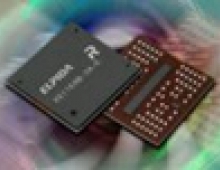
Intel's push for DDR2 lowers chip prices
DRAM makers have cut their spot prices for 512Mbit DDR2 533MHz chips to as low as US$5.99.
The average spot price dropped to US$7.20 yesterday, down from US$7.66 earlier in the week, as makers
anticipate recent Intel policies may provide makers with an opportunity to promote the adoption of DDR2.
Intel has told several major clients that it has decided to aggressively migrate its desktop chipset business to the 915 platform starting this quarter, sources indicated. Intel plans to begin phasing out its 845 chipsets starting in the second quarter with the part being completely phased out by the end of the third quarter.
According to Intel's website, first-tier DRAM makers, including Elpida, Infineon Technologies, Hynix Semiconductor, Micron Technology and Nanya Technology, have gained validation for their 512Mbit DDR2 chips.
However, the 915 platform supports both DDR and DDR2, and the price difference between the two memories has hindered DDR2?s adoption on the 915 platform. Therefore, Taiwan-based DRAM makers have started lowering their quotes for 512Mbit DDR2 chips recently, sources at a financial firm indicated.
With 512Mbit DDR2 chip prices falling, the segment stands a good chance of overtaking DDR to become the mainstream, an analyst pointed out.
In addition, prices for the segment also fell because DRAM makers are improving yields at 0.11-micron process production and packaging and testing capacity is expanding, according to the Chinese-language Economic Daily News.
Frank Huang, chairman of Taiwan's leading DRAM vendor, Powerchip Semiconductor Corporation (PSC), was also quoted by the paper as saying that PSC plans to see DDR2 account for 40% of its total DRAM production by next quarter.
Intel has told several major clients that it has decided to aggressively migrate its desktop chipset business to the 915 platform starting this quarter, sources indicated. Intel plans to begin phasing out its 845 chipsets starting in the second quarter with the part being completely phased out by the end of the third quarter.
According to Intel's website, first-tier DRAM makers, including Elpida, Infineon Technologies, Hynix Semiconductor, Micron Technology and Nanya Technology, have gained validation for their 512Mbit DDR2 chips.
However, the 915 platform supports both DDR and DDR2, and the price difference between the two memories has hindered DDR2?s adoption on the 915 platform. Therefore, Taiwan-based DRAM makers have started lowering their quotes for 512Mbit DDR2 chips recently, sources at a financial firm indicated.
With 512Mbit DDR2 chip prices falling, the segment stands a good chance of overtaking DDR to become the mainstream, an analyst pointed out.
In addition, prices for the segment also fell because DRAM makers are improving yields at 0.11-micron process production and packaging and testing capacity is expanding, according to the Chinese-language Economic Daily News.
Frank Huang, chairman of Taiwan's leading DRAM vendor, Powerchip Semiconductor Corporation (PSC), was also quoted by the paper as saying that PSC plans to see DDR2 account for 40% of its total DRAM production by next quarter.

















